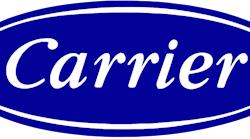A cooling tower is only as good as the details of its design and the specification of its supporting components. Details such as pump net positive suction head (NPSH), strainers, and pipe size can have a major impact on performance and energy bills. Make sure the impact is positive by keeping the following in mind.
A STRAINER AT THE TOWER INLET CAN PREVENT HEADACHES AFTER START-UP
When cooling towers are replaced, the system and piping often are not. When the system is filled and started, water flows from the tower, through the pump, through the chiller, and to the tower spray nozzles. Eventually, pump-discharge pressure increases and flow decreases, indicating a problem. Building personnel blow down or pull and clean/replace the pump inlet strainers, which are loaded with dirt/scale. When the system is started again, pump-discharge pressure still is high, and low flow persists.
What is the problem?
The problem is that the pump inlet strainers catch only dirt and debris between the tower outlet and the pump inlet. They do nothing to remove dirt and scale originating between the pump outlet/chiller and the tower. There is a good chance that some, if not all, of the tower nozzles will be partially blocked. Removing and cleaning each nozzle will be expensive and time-consuming. Making matters worse is that the nozzles likely will plug again as soon as the system is restarted.
For this reason, in systems with questionable water-treatment practices and systems that have been drained or dormant, consider installing a new strainer, block valves, and inlet- and outlet-pressure gauges on the common header just prior to the tower inlet. Utilize a strainer that can be opened, cleaned, and placed back into service quickly. In some systems, this new “tower strainer” will have to be cleaned several times a day for the first week or two of service to remove all of the dirt and scale in the system. However, cleaning a strainer like this usually can be done quickly with in-house personnel.
DO NOT UNDERSIZE THE EQUALIZING LINE
Water drains out of a cooling tower's cold-water basin via gravity. Typically, between the cold-water basin and the point of connection for the common return header is only a few feet of vertical drop. As a result, the pressure differential between the tower and the common header may be only a few feet (or even inches) of water column.
History has shown that even minor differences in piping geometry between cell outlets and the point of common connection on return headers can have a profound effect on how water drains from tower cells. In some instances, differences in cell-outlet pipe length of only 5 to 10 ft have resulted in one cell basin running nearly empty while the other overflows. A common field “fix” is to balance water flow between the two cells. Tower performance will be affected, however, as one cell will be receiving extra water, while the other will be receiving less and not performing at its rated conditions. This situation easily can be avoided by paying attention to the design and sizing of the equalizing line. Follow the tower manufacturer's recommended guidelines, and make the tower-outlet piping from each cell identical. If it is not identical, slightly oversize it from the cells to the header.
WATCH THE PUMP NPSH
When an existing roof structure will not support the weight of a new cooling tower — as is the case in many retrofit situations — the cooling tower may be installed on a different support platform, perhaps one adjacent to the building. Rarely does the support platform reach the height of the building's roof. Often, the tower cold-water basin is located only 10 to 12 ft above ground.
If pumps are to be installed on a foundation and base, only a few feet below a tower basin, it is imperative that low-NPSH-required (NPSHR) pumps be utilized and that there be a safety factor in the NPSH available (NPSHA)/NPSHR. A pump selected at NPSHA is a problem waiting to happen. No one wants to tell an owner that the reason his or her brand-new pumps sound as if they are pumping marbles is that they were selected improperly and are going to have to be replaced.
In situations in which a tower is located on an elevated structure, but only 5 or 10 ft above grade, avoid up and down runs of tower-discharge piping, especially to a level higher than that of the cold-water basin. Though unusual, this has been witnessed by the author on two occasions, causing the following problems:
-
When pumps were shut off, water in upward-sloped pipe ran backward into the tower, causing it to overflow.
-
Elevated discharge pipe acted as an air trap. Eventually, air filled the pipe and “slugged” through the system, damaging the pumps and causing the chillers to trip off line because of lost flow. Because the suction piping often ran at a vacuum condition, the air could not be vented by conventional means.
LOCATE THE COOLING TOWER AWAY FROM ACTIVE AREAS
Cooling towers launch water vapor and a small amount of liquid into the air, a phenomenon known as drift loss. Depending on the amount of drift loss and the weather, a mist may be felt in the area surrounding the cooling tower. Normally, this is not a problem. But if a cooling tower is located on a roof directly above or adjacent to a pedestrian thoroughfare or parking lot, mist detectable by pedestrians quickly can turn into an air-quality issue. Is the water safe? What chemicals are used? What microorganisms are in the water? Mist landing and then drying on parked cars also can pose problems. Try explaining to the CEO that the mist is no big deal and that he simply needs to get his car washed every other day.
The installation of extra or high-efficiency drift eliminators may solve the problem of drift loss. However, it will not stop water vapor in the air from condensing and then blowing into a parking lot. In short, do yourself a favor, and locate cooling towers as far from active areas as possible.
Keith Rinaldi, CEM, is vice president of Dome-Tech Field Engineering Services.








